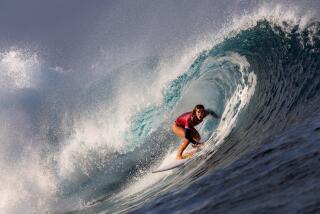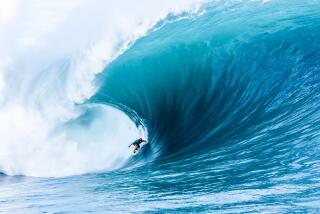William Finnegan surfs the meaning of his ‘Barbarian Days’
- Share via
William Finnegan is a staff writer at the New Yorker where, for nearly three decades, he’s covered civil wars (in South Sudan and Somalia), tracked narcotraficantes (in Mexico) and embedded with gangs of neo-Nazi teens (in the Antelope Valley). Before he was a celebrated magazine writer (and author of five books), he taught high school in a poor, black part of Cape Town, South Africa; tended bar and washed pots on Australia’s Gold Coast; worked the freight trains as a brakeman on the Southern Pacific; and pumped gas in the San Fernando Valley.
Before, during and after all those careers, in nearly every stage of his life, Finnegan has surfed. Surfing is the through line, the one constant in a peripatetic life.
Surfing, he realizes deep into this sweeping, glorious memoir, is home. “With me it’s not a matter of packing up or staying on,” he writes, “but rather of being always half poised to flee … to throw myself into some nearby patch of ocean. … That cracking, fugitive patch is where I come from.”
Summer reading guide: The 136 books you’ll want to read
“Barbarian Days” is as much a recollection and observation of a life among the swells as it is a reckoning with this “fugitive patch.” He first spotted it when he was 10, watching a break off the Ventura pier while eating with his family.
The surfers “were silhouettes, backlit by low sun, and they danced silently through the glare, their boards like big dark blades, slashing and gliding, swift beneath their feet.” He wanted to be out there and soon; that summer, in San Onofre, he was.
His life in Southern California in the 1950s and early ‘60s sounds in many ways halcyon, full of beach gear and Volkswagen buses and wharf rats and characters with “PhDs in having fun.” It’s also filled with violence. He boxes friends in his front yard, gets into fistfight after fistfight. The fighting gets only worse after the Finnegans (there are six of them) pick up and move to Honolulu. His time in a poor, public junior high “was occupied almost entirely by the rigors of bullies, loneliness, fights, and finding my way, after a lifetime of unconscious whiteness in the segregated suburbs of California, in a racialized world.”
It’s here in Hawaii that the book, and Finnegan’s serious surfing, begins. At school he falls in with a white gang called the In Crowd, whose racism was “situationist, not doctrinaire.” The beach they live closest to was “just a patch of damp sand, narrow and empty.” Paradise, like anywhere else, is more complicated and ugly up close.
He befriends Glenn Kaulukukui, an excellent surfer his age from an ohana, a surfing family whose seriousness and style Finnegan admires. “These people never appeared in mainland magazines,” he writes. Surfing, Finnegan realizes, is a way into places, people, and a whole language that would otherwise have been hidden. Finding the hidden — the search — is what it’s all about.
A minor complaint on the language: Finnegan has a tendency to earnestly overexplain, particularly in early chapters. Sets are “larger waves, which usually come in groups”; to have a place “wired” is to “come to understand [it] deeply”; offshore winds, “as I hope I’ve made clear, wreathe waves in glory.” It’s a nearly 450-page book filled with majestic passages on breaks and rides; trust us to figure the lingo out on our own.
But, oh, the rides, they are incandescent. In Fiji, where Finnegan and his friend Bryan are among the first to discover a nearly perfect break, Tavarua (which later became legendary), the waves felt like “a runaway train, an eruption of magical realism, with that ocean-bottom light and lacy white canopy.” In Hawaii, paddling out on LSD “one of the backwash warbles ghosting across the big green unbroken face spoke to me.” A colossal wave breaking atop Finnegan gives off a sound “preternaturally low, a basso profundo of utter violence.”
Like paradise, up close, surfing can be ugly too. And useless. And lonely. And deadly. Surfing is “a track that led away from citizenship … toward a scratched out frontier where we would live as latter-day barbarians.” Many of the most memorable, vivid sessions in the waves end with Finnegan or a companion crawling onto shore after nearly dying, yet alive to the world, weeping uncontrollably.
It’s here, also, in his “fugitive patch” that Finnegan’s found some of his best friends, and he studies these relationships as closely as any break. The most intriguing character is certainly Doc, a San Francisco big wave surfer and physician named Mark Renneker, who Finnegan profiled in the New Yorker: a “fanatics’ fanatic” in “a sport really open only to the absurdly dedicated.”
In New York, where Finnegan now lives and surfs, his friend John Selya, an accomplished Broadway dancer, delivers one of the best descriptions of surfing’s hold on his life: With music, as with waves, he says, you are “yielding to something more powerful than yourself.”
I’d sooner press this book upon on a nonsurfer, in part because nothing I’ve read so accurately describes the feeling of being stoked or the despair of being held under. But also because while it is a book about “A Surfing Life” — as the subtitle states — it’s also about a writer’s life and, even more generally, a quester’s life, more carefully observed and precisely rendered than any I’ve read in a long time.
A life in search, as Finnegan puts it, of “unmapped worlds, unborn language. This was what I was chasing: not the exotic, but a broad-beamed understanding of what is what.”
::
Barbarian Days
A Surfing Life
William Finnegan
Penguin Press: 464 pp., $27.95
in Los Angeles.
MORE FROM BOOKS:
Get ready to be obsessed by these 29 page-turners
27 nonfiction books you’ll want to read -- and share -- this summer
Listen up: Here are 11 audiobooks you’ll want to ‘read’ this summer
More to Read
Sign up for our Book Club newsletter
Get the latest news, events and more from the Los Angeles Times Book Club, and help us get L.A. reading and talking.
You may occasionally receive promotional content from the Los Angeles Times.






